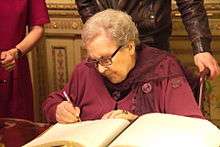Neus Català

Neus Català Pallejà (Els Guiamets, province of Tarragona; October 6, 1915),[1] was a member of the Unified Socialist Party of Catalonia (Catalan: Partit Socialista Unificat de Catalunya, PSUC) during the Spanish Civil War and is the only Spanish survivor of the concentration camp of Ravensbrück. She turned 100 in October 2015.[2]
Biography
Neus Català was born on October 6, 1915 in Els Guiamets (Priorat, Tarragona, Catalonia). However, her godmother officially registered her birth on June 15 of that year, because of the disappearance of the documentation of the Municipality of Barcelona after the Spanish Civil War. This date is considered official and was used to celebrate the centenary of her birth. Català obtained her nursing degree in 1937 and moved to Barcelona at the beginning of the Spanish Civil War. In 1939, she crossed the French border, taking with her 180 orphaned children of the colony Las Acacias from Premià de Dalt, better known as the Children of Negrin. She collaborated with her husband, the Occitan, Albert Roger,[3] in the activities of the French Resistance, centralizing (at her home) the reception and transmission of messages, documents, weapons, and sheltering political refugees. She was reported to the Nazi authorities by a pharmacist of Sarlat. She and her husband were later arrested by the Nazis in 1943. Català was imprisoned and mistreated in Limoges, and in 1944 she was deported to Ravensbrück, where she was forced to work in the armaments industry. There, she was part of the "Lazy Commandos" (Spanish: Comando de las gandulas), a group of women who boycotted the manufacture of weapons in Holleischen, a factory which depended on the concentration camp of Flossenburg.[4] Thanks to sabotage, the facility produced about 10 million faulty bullets and marred numerous weapons making machines.[5] After her release, she returned to France where she continued her clandestine struggle against Franco. She lived in Sarcelles, near the city of Paris, and chaired the Association of Victims of Ravensbrück.[6] Currently, she continues her membership in the Communist Party of Catalonia (PCC), United and Alternative Left (EUiA), and the Pere Ardiaca Foundation, of which she is a member of honor.
Recognition
The Generalitat of Catalonia awarded her the Cross of St. George in 2005, and later she was chosen Catalan Person of the Year in 2006 for her defense of the memory of the more than 92,000 women who died in Ravensbrück. In 2006 she also received the Award for Alternative granted by the United and Alternative Left. On October 29, 2014, at the age of 99, the Barcelona City Council awarded Català the Gold Medal of Civic Merit, in recognition for her work to preserve historical memory, the fight against fascism, and the defense of women. In 2015, she received the Gold Medal of the Generalitat of Catalonia, for her struggle for justice and democratic freedom, the memory of those deported to Nazi death camps, and the defense of human rights.[7]
Neus Català's Year
Catalonia has dedicated 2015 to the memory of Català, who, about to turn one hundred years old, is the last person in Spain that has survived Ravensbrück. This commemoration pays tribute, by extension, to all those who suffered the consequences of war, the fascist dictatorship, and internment in prison camps and death camps. During the presentation, the Minister of Welfare and Family said, "She is a strong and caring woman, an antifascist fighter, a survivor of the Nazi death camps, and the reference and testimony for all the women who fought in the Spanish Civil War and World War II."[8]
References
- ↑
- ↑ Staff (2015-10-06). "Neus Català fa 100 anys" (in Spanish). Televisió de Catalunya. Retrieved 2016-08-23.
- ↑ Creus, Jordi (2007). Dones contra Franco. Barcelona: Ara Llibres.
- ↑ ACN, Falset (14/06/2015).
- ↑ «Neus Català».
- ↑ Creus, Jordi (2007). Dones contra Franco. Barcelona: Ara Llibres.
- ↑ March, Oriol.
- ↑ Catalunya dedica el 2015 a Neus Català, l'ùltima supervivent de Ravensbrück.
Bibliography
- Neus Català, De la resistencia y la deportación: 50 testimonios de mujeres españolas, Barcelona, Península, 2005, ISBN 84-8307-283-1
- Elisenda Belenguer, Neus Català : memòria i lluita, Barcelona, Fundació Pere Ardiaca, 2006, ISBN 978-84-935342-0-2
- Mar Trallero, "Neus Català: la mujer antifascista en Europa", Barcelona, Mina, 2008, ISBN 978-84-96499-94-2
- Carme Martí, Un cel de plom (novela), Barcelona: Amsterdam llibres, 2012. ISBN 978-84-15224-51-8
- Carme Martí, Cenizas en el cielo (novela, traducción de Un cel de plom): Roca Editorial, 2012. ISBN 978-84-9918-455-5
Links
- www.neuscatala.cat